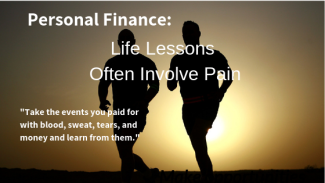
How Training for a Marathon is like Managing Your Finances: Lesson 13
By Gary Silverman, CFP®
Passing mile 13, I was almost half-way done with my marathon. Things were going well. Tulsa is known as a hilly course, especially the second half with its rolling hills steadily gaining elevation. This is what I trained for. Wichita Falls is not known as a hilly area, but if there is a hill around town you probably saw me running up it at some time in the months leading up to the race.
Six weeks before the marathon I took on a greater challenge. Muenster has a nice half-marathon race built around their Octoberfest. It’s a great time even if you don’t run because of the festivities. I was there to get some more miles under my belt but for another reason as well…the countryside around Muenster is hilly...very hilly. It would give me experience running long over hills in a race environment.
I learned a lot in that race. That knowledge helped me tweak the pace I’d be taking up and down hills, gave me a lot of practice in foot placement and body movement on some of the steeper ones, and showed me that some of my fueling (snacks while running) needed to change. I performed very well. I earned first in my age group! (Full disclosure: I was the only one in my age group.)
Two weeks later (four weeks before the marathon) I did my long run. Now, I agree that a mile is a long run. But in most marathon training plans, including mine, there is THE long run. Mine was a 20-mile beast I did on the outskirts of Wichita Falls and the hilly areas around Tanglewood and The Bluffs.
That’s where I learned about pain.
Reading about running on hills is a lot different than experiencing it. Reading about runners “hitting the wall” is certainly different than experiencing it. And like any experience, it only does you good if you remember it and modify your behavior based on the lessons learned.
I was honestly surprised in 2008 when I was told by people that they had no idea the market could be so violent and unforgiving. After all, most of these people were around for the Tech Bubble Burst, the market shut-down and crash after 9-11, and the recession of 2002. In those three years the stock market went down about as much as it did in 2007-08. They just forgot about the lessons they learned.
Life lessons often involve pain. It might not be physical but watching your nest-egg drop 50% is not what most would call fun. Take the events you paid for with blood, sweat, tears, and money and learn from them. Then modify your behavior based on the new knowledge you have. Then remember the lesson.
As far as my marathon run, all was going fine. My training and experience on hills were paying off. Then shortly after mile 16 my lessons on pain would be put to the test.
Gary Silverman, CFP® is the founder of Personal Money Planning, LLC, a Wichita Falls retirement planning and investment management firm and author of Real World Investing

